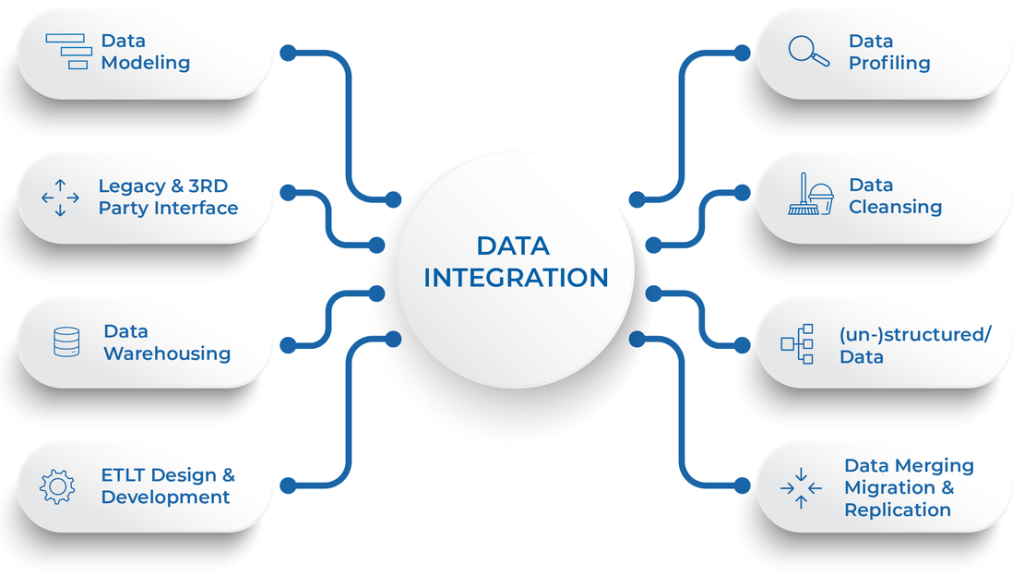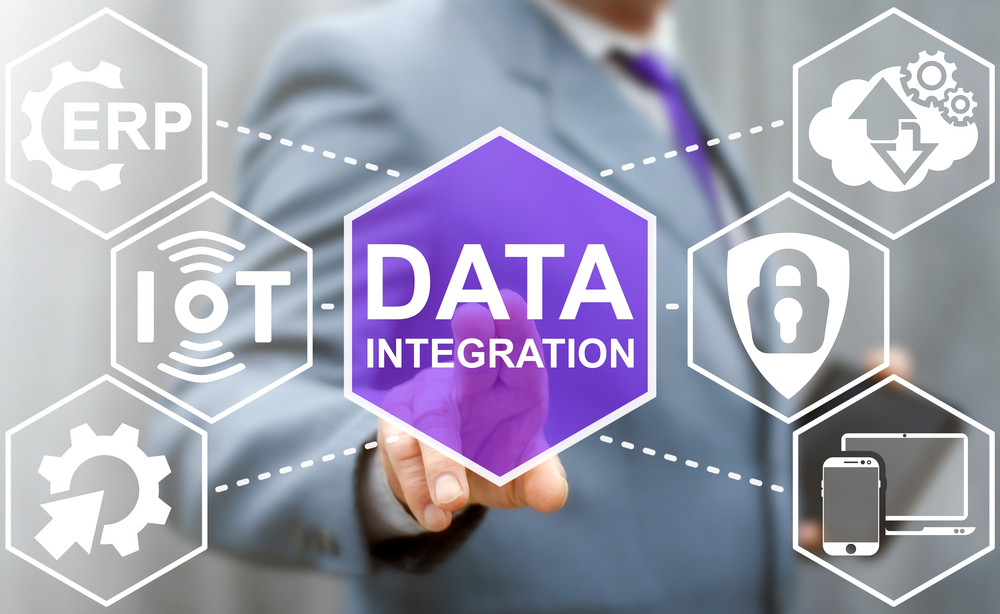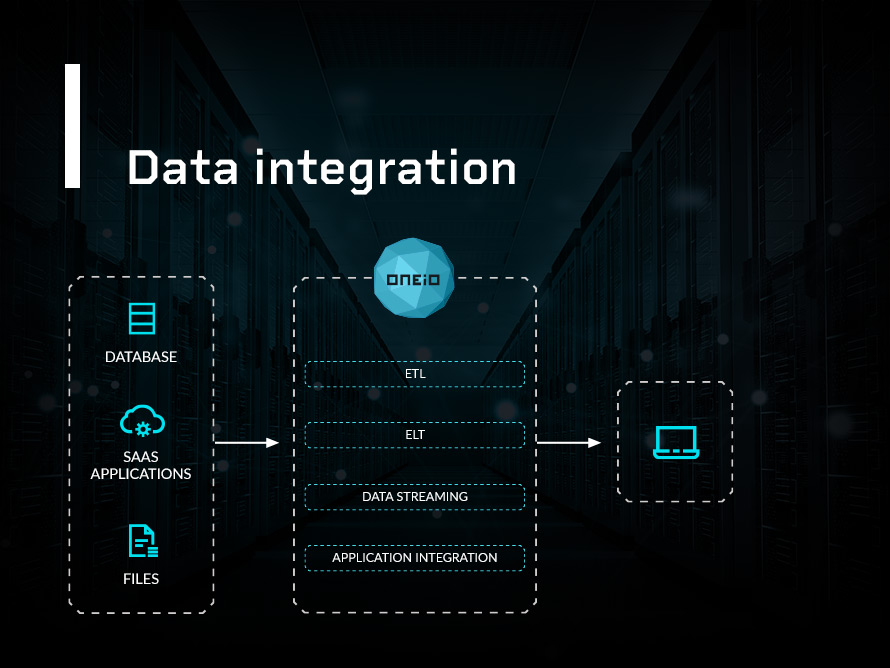Data integration has become an essential aspect of modern businesses, regardless of their size or industry. With the rise of big data and the increasing need for data-driven decision-making, organizations are turning to data integration to streamline their processes and improve overall efficiency. In this article, we will delve into the world of this process, exploring its definition, importance, and benefits in detail.
Definition of Data Integration
Data integration is the process of combining data from various sources, both internal and external, into a unified, accurate, and up-to-date dataset. This includes data from databases, spreadsheets, web services, and other sources. The aim of it is to provide a complete view of an organization’s data assets, enabling better analysis and decision-making.
The process of integrating data involves three main steps: copying, importing, and transforming data. First, data is copied from source systems and imported into a target repository, such as a data warehouse, data lake, or data Lakehouse. Then, the data is transformed to align with the target system’s format and structure. This could include data cleaning, standardization, and normalization.

Overview of the data integration
It plays a crucial role in creating a single source of truth for an organization’s data. It allows for data from different systems to be merged, eliminating data silos and providing a holistic view of an organization’s operations.
Importance of Data Integration
Data integration has become a key part of modern businesses due to its many benefits and advantages. Let’s take a closer look at why integrating data is important for organizations today.

The significance of the data integration
Improved Business Efficiency
One of the primary reasons for data integration is to improve overall business efficiency. By combining data from different sources, organizations can streamline their processes and eliminate manual data entry and duplication. This saves time and resources, allowing employees to focus on more critical tasks.
Moreover, data integration enables smooth access to crucial data for various business functions like order processing, customer support, and loan approval. This eliminates the need for employees to switch between different systems and databases, increasing productivity and reducing errors.
Data-driven Decision Making
Data integration plays a vital role in enabling data-driven decision-making. With a unified view of an organization’s data, executives and decision-makers can gain insights into key performance indicators, customer behavior, production operations, and other aspects of the business. This allows them to make informed decisions based on accurate and up-to-date data.
Having a complete view of data also helps identify trends and patterns that may not be apparent when looking at individual datasets. This can give organizations a competitive edge by identifying new opportunities and potential risks.
Enhanced Data Quality
Data quality is another crucial aspect of data integration. By combining data from various sources, organizations can ensure that their data is clean, consistent, and error-free. This includes identifying and correcting any inconsistencies or discrepancies in data, as well as removing duplicate or outdated records.
Data integration helps maintain data quality by standardizing and normalizing data from different systems, ensuring that it is structured and formatted consistently. This improves the accuracy and reliability of data, making it more useful for analysis and decision-making.
Easy Data Access
With traditional data management approaches, employees often struggle to access the data they need. This could be due to data silos, complex data structures, or limited access rights. Data integration solves this problem by providing convenient access to data through data warehouses or centralized repositories.
This means that data scientists, analysts, and business intelligence users can easily access the data they need without having to navigate through multiple systems or databases. It also allows for self-service analytics, where users can create their own reports and visualizations without relying on IT teams.
Reduced Data Silos
Data silos occur when data is stored in different systems or departments, making it difficult to share or access information. This results in a lack of collaboration and transparency within an organization. Data integration eliminates data silos by bringing data from different sources into one central repository.
Having all data in one place promotes collaboration between teams and departments, allowing for better communication and decision-making. It also ensures that everyone is working with the same set of data, reducing the risk of errors and inconsistencies.
Increased User Productivity
Data integration can significantly increase user productivity by reducing the time spent searching for data. With easy access to a centralized repository of data, employees can quickly find the information they need without having to switch between systems or rely on others.
This frees up time for employees to focus on more critical tasks, ultimately improving overall efficiency and productivity. It also reduces the burden on IT teams, who no longer have to spend time fulfilling ad hoc data requests.
Data-driven Business Operations
In today’s digital age, data is a valuable asset for organizations looking to stay competitive. Data integration enables businesses to use data to drive their operations, from strategic planning to operational decision-making.
Having a complete view of data allows organizations to identify trends and patterns, track performance, and make data-driven decisions to improve business operations. It can also help identify areas for improvement and cost-saving opportunities, ultimately leading to better business outcomes.
Types of Data Integration
There are various types of data integration, each with its own benefits and use cases. Let’s take a look at some of the most common types of data integration.

Types of the data integration
Traditional Data Integration
Traditional data integration involves combining data from various sources and storing it in a centralized repository, such as a data warehouse or data lake. This type of integration is commonly used in enterprises with large and complex datasets.
Traditional data integration tends to be more time-consuming and resource-intensive, as it requires extensive coding and ETL (extract, transform, load) processes to consolidate data. It is also typically done on-premises, making it less flexible and scalable than other types of data integration.
Cloud-based Data Integration
With the rise of cloud computing, many organizations are opting for cloud-based data integration solutions. This involves moving data to the cloud, where it can be accessed and integrated using various tools and technologies.
Cloud-based data integration offers several advantages, including scalability, flexibility, and cost-effectiveness. It also allows for real-time data integration, making it ideal for organizations that need to process and analyze large volumes of data quickly.
Real-time Data Integration
Real-time data integration involves processing and integrating data in real-time as it is generated. This is particularly useful for organizations that need to make quick and data-driven decisions.
Real-time data integration relies on technologies like Apache Kafka and Apache Spark to capture, transform, and route data in real-time. This type of integration is commonly used in industries like finance, healthcare, and e-commerce, where data needs to be processed rapidly.
Challenges of Data Integration
While data integration offers many benefits, it also comes with its fair share of challenges. Let’s take a look at some of the common challenges organizations face when implementing data integration.
Data Quality and Consistency
Ensuring data quality and consistency is a major challenge for organizations implementing this process. Combining data from various sources can result in data inconsistencies, errors, and duplication, making it difficult to trust the accuracy of data.
To overcome this challenge, organizations must have proper data governance processes in place. This includes standardizing and normalizing data, as well as regularly monitoring and evaluating data quality to identify and correct any issues.
Technical Complexities
Data integration is a complex process that requires technical expertise and resources. Organizations must invest in the right tools and technologies and have skilled IT teams who can manage and maintain the integration process.
Moreover, integrating data from different systems and formats can be challenging, especially if the source systems are outdated or use legacy technologies. This requires careful planning and implementation to ensure that the integration process runs smoothly.
Cost Implications
Implementing data integration can be costly, particularly for smaller organizations with limited budgets. The cost includes not only the tools and technologies needed but also the time and resources required for proper planning, implementation, and maintenance.
Organizations must carefully consider the costs and benefits of integrating data before embarking on the project. This includes evaluating the potential return on investment and weighing it against the costs involved.
Best Practices for Data Integration
To ensure the success of data integration, organizations must follow best practices and guidelines. These will help them overcome common challenges and achieve their objectives. Here are some best practices to keep in mind when implementing this process.
Define Clear Objectives
Before starting the process of integrating data, organizations must define clear objectives and goals. This includes identifying what data needs to be integrated, why it needs to be integrated, and what the end goals are.
Having a clear understanding of objectives will help organizations determine the best approach and tools for integration. It will also ensure that the integration process aligns with the organization’s overall business strategy.
Choose the Right Tools and Technologies
Choosing the right tools and technologies is crucial for successful in the process of integrating data. Organizations must carefully evaluate their options and choose tools that are scalable, flexible, and cost-effective.
Moreover, it is essential to select tools that can handle different types of data and integrate with various systems and databases. This will ensure that the organization is not limited in its ability to integrate data from different sources.
Focus on Data Governance
Data governance is a critical aspect of data integration. Without proper governance processes in place, organizations risk data inconsistency, duplication, and poor quality. Data governance ensures that data is standardized, secure, and trustworthy.
Organizations must have a dedicated team responsible for managing data governance and ensuring that data is clean, accurate, and reliable. This team should also regularly monitor and evaluate data quality and make necessary improvements.
Maintain Data Security
Data security is of utmost importance when it comes to data integration. With sensitive data being shared and accessed from various sources, organizations must have proper security measures in place to protect their data.
This includes implementing role-based access controls, encrypting data, and regularly auditing data access and usage. Organizations must also ensure that the tools and technologies used for data integration comply with data security regulations.
Regularly Monitor and Evaluate
Data integration is an ongoing process, and it is essential to regularly monitor and evaluate its effectiveness. This involves tracking key performance indicators, identifying areas for improvement, and making necessary changes to optimize the process.
By regularly monitoring and evaluating data integration, organizations can ensure that they are achieving their goals and objectives and identify any issues that need to be addressed.
Conclusion
In today’s data-driven world, data integration has become an essential aspect of modern businesses. By combining data from various sources and creating a single source of truth, organizations can gain valuable insights and make informed decisions.
In this article, we have explored the definition and its importance in today’s business landscape. We have also discussed the different types, common challenges, and best practices to follow when implementing integrating data.
Data integration is not without its challenges, but with careful planning, implementation, and maintenance, organizations can reap its many benefits. By choosing the right tools and following best practices, organizations can achieve seamless this process and drive their business forward.


